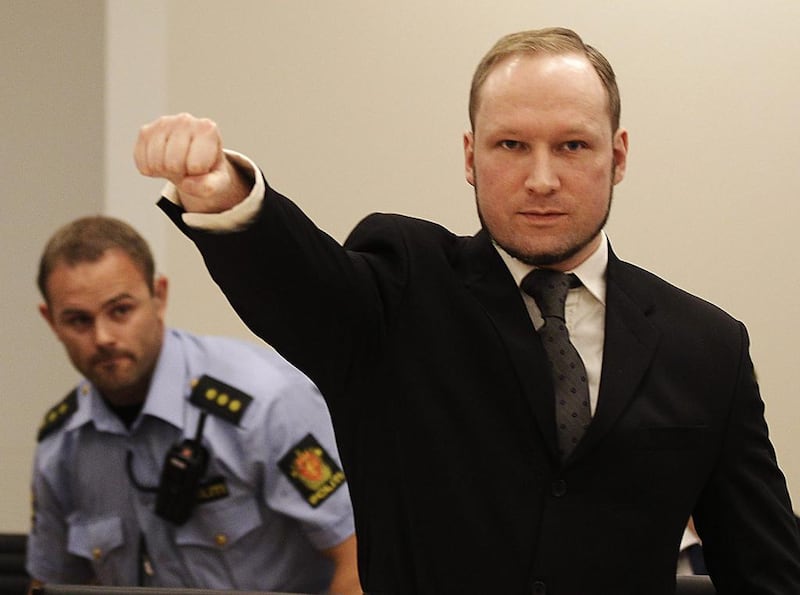While Europe struggles with another ISIL-inspired atrocity – the Copenhagen shooting – several new books are reminding us of the Oslo attacks. The perpetrator, Anders Behring Breivik, described his killing spree as “the most sophisticated and spectacular attack” on the continent since the Second World War. On July 22, 2011, Breivik set off a car bomb by the prime minister’s office in Oslo that killed eight people, and then made his way to a youth resort on the island of Utoya, where he hunted down and shot 69 others.
Many commentators have quite rightly denied any religious equivalence between Breivik’s murders and those in Paris and Copenhagen. Characterising the former as an act of “Christian extremism” and the latter two as acts of “Muslim extremism” would be reductionist to the point of category error.
But new accounts of the life of Breivik and analyses of the rise of the far right in Scandinavia point to a symbiosis of extremism. Both those who claim Islamic justification for their actions and the “Eurabia” conspiracy theorists, who argue there is a plot to Islamise Europe, effectively feed off and even copy each other.
Anticipating the ghastly videos of ISIL, Breivik had planned to decapitate the former Norwegian prime minister Gro Harlem Brundtland and film the execution on an iPhone. Fortunately, Mrs Brundtland had left before Breivik arrived on the island, but he defended his plan during his trial. “It is a strategy taken from Al Qaeda,” he said. “It is a very potent psychological weapon.”
Likewise, as detailed in new books by Asne Seierstad, Sindre Bangstan and Aage Borchgrevink, there are Muslims in Europe who fit the bogeyman stereotype that the likes of Breivik say are commonplace.
Thousands of young Europeans are known to have travelled to Syria and Iraq to join ISIL. One Norwegian supporter, Ubaydullah Hussain, was interviewed last summer and strongly advocated the group’s methods. “Beheading is not torture,” he said. “People die instantly, as opposed to what the West does with Muslim prisoners.”
Both extremes are, however, mostly reacting to misplaced and mistaken fears. Whatever the history of catastrophic blunders perpetrated by the US and the West in the Middle East, there is no plot to undermine Muslim countries or desecrate the holy places.
Similarly, there is no secret plan to Islamise Europe and the numbers and doings of local Muslim populations are consistently overestimated.
In 2009, for instance, Switzerland voted to forbid the construction of any more minarets. One might have imagined that the country’s fabled Alpine vistas were in danger of being interrupted by a series of Islamic towers, and the bucolic yodelling of lederhosen-clad farmers drowned out by the calls to prayer. At the time, however, the precise number of mosques with minarets in the whole of Switzerland was just four.
Myths gather wings, just as British tabloids claim almost every year that loony left wing councils are trying to ban Christmas and replace it with a secular “Winterval”. The lack of facts to support this assertion never troubles them.
This way of thinking on extremism is much more serious than that. And precisely because the lies, exaggerations and misrepresentations suit both sides, there needs to be much more aggressive policing to stop these claims going mainstream. This is difficult to do in the age of the internet, yes, but it is an important effort and one that trusted sources – such as the websites of respected newspapers and magazines – ought to be specially vigorous in enforcing.
Take, for instance, Bat Ye’or, the author who came up with the “Eurabia” thesis. Her bizarre and Islamophobic theories have been given huge credibility that has allowed them to seep beyond the online badlands because the leading historian Niall Ferguson once said of her: “No writer has done more than Bat Ye’or to draw attention to the menacing character of Islamic extremism. Future historians will one day regard her coinage of the term ‘Eurabia’ as prophetic. Those who wish to live in a free society must be eternally vigilant. Bat Ye’or’s vigilance is unrivalled.”
Mr Ferguson is a professor at Harvard and the author of numerous highly regarded bestsellers. One has to hope that he has not read her books too closely, unless he too believes that Europe has been “active in its own Islamisation” and that a joint EU-OIC alliance has been working for “the demise of Israel” and the OIC’s “conquest of the Christian West”.
But the policing has to be of all extremists. That means that there is a responsibility for Islamic authorities to provide very clear guidance to the young and impressionable about what is right and wrong. There obviously is a need for greater clarity and explanation here. Why, otherwise would misguided young people from around the world be heading off to join ISIL?
Such careful guardianship of facts, of recorded history, of the truth of events, should serve the path of moderation by discouraging new recruits to extremism. But it also undermines existing fanatics.
An Anders Breivik and an Ubaydullah Hussain both need each other, for they provide proof for their respective claims. “See?” they both can say, “they really are out to destroy us.” Remove one, and the other’s hateful assertions are shown to be as baseless and manufactured as they have always been.
Sholto Byrnes is a Senior Fellow at the Institute of Strategic and International Studies, Malaysia





